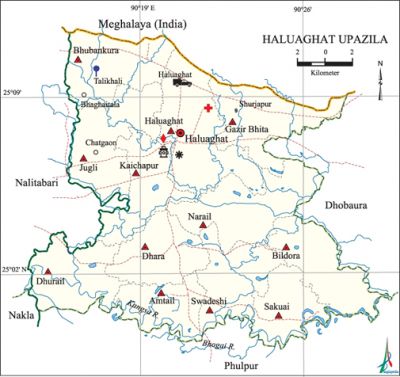Haluaghat Upazila
Haluaghat Upazila (mymensingh district) area 357.61 sq km, located in between 24°59' and 25°12' north latitudes and in between 90°14' and 90°33' east longitudes. It is bounded by the Meghalaya state of India on the north, phulpur upazila on the south, dhobaura upazila on the east and nalitabari upazila on the west.
Population Total 290043; male 142632, female 147411; Muslim 264933, Hindu 12089, Buddhist 3, Christian 12772 and others 246. Indigenous communities such as garo, hajong, Koch, Dalu, Bangshi Barman, Khatrio, Hadi, Kurmi, Mal belong to this upazila.
Water bodies Main rivers: kangsa, Menong, Bhogai.
Administration Haluaghat Thana was formed in 1916 and it was turned into an upazila in 1983.
| Upazila | ||||||||
| Municipality | Union | Mouza | Village | Population | Density (per sq km) | Literacy rate (%) | ||
| Urban | Rural | Urban | Rural | |||||
| - | 12 | 145 | 214 | 11710 | 278333 | 811 | 71.8 | 37.4 |
| Upazila Town | ||||||||
|
Area |
Mouza |
Population |
Density |
Literacy rate | ||||
| 2.76 | 2 | 11710 | 4243 | 71.8 | ||||
| Union | ||||
| Name of union and GO code | Area (acre) | Population | Literacy rate (%) | |
| Male | Female | |||
| Amtail 06 | 5544 | 10075 | 10663 | 39.0 |
| Kaichapur 74 | 6560 | 9213 | 9639 | 36.7 |
| Gazir Bhita 47 | 7868 | 10042 | 10520 | 37.1 |
| Jugli 67 | 8363 | 11463 | 12060 | 37.2 |
| Dhara 33 | 6450 | 14269 | 14303 | 38.9 |
| Dhurail 40 | 6915 | 12315 | 12704 | 32.8 |
| Narail 81 | 9100 | 11031 | 11060 | 31.3 |
| Bildora 21 | 7002 | 10457 | 10710 | 32.0 |
| Bhubankura 20 | 7898 | 9960 | 10620 | 41.9 |
| Sakuai 84 | 5169 | 9186 | 9546 | 41.0 |
| Swadeshi 94 | 6850 | 10695 | 11226 | 37.5 |
| Haluaghat 61 | 10650 | 23926 | 24360 | 49.0 |
Source Bangladesh Population Census 2011, Bangladesh Bureau of Statistics.

War of Liberation A frontal battle was fought between the freedom fighters and the Pak army on 6 August 1971 at the Bandarkata Camp in which freedom fighters Abdul Aziz and Parimal were killed. On 3 November the freedom fighters launched an attack on the Pak army base at Telikhali simultaneously from three sides – Karaitala, Baghaitala and Ramchandrakura; in this battle 121 Pakistani soldiers were killed and so were 26 freedom fighters. There are two mass graves in the upazila; 6 memorial monuments had been built.
For details: see হালুয়াঘাট উপজেলা, বাংলাদেশ মুক্তিযুদ্ধ জ্ঞানকোষ (Encyclopedia of Bangladesh War of Liberation), বাংলাদেশ এশিয়াটিক সোসাইটি, ঢাকা ২০২০, খণ্ড ১০।
Religious institutions Mosque 441, temple 16, church 6. Noted religious institutions: Haluaghat Dhanhata Jami Mosque, Markas Mosque, Ramsundar Mandir, Beroidakuni Catholic Church (1928), Church of England or Oxford Church (Anglican Church), Akanpara Seven Day Adventist Mission, Rangrapara Garo Baptist Convention Mission, St. Andrewkim Catholic Mission, Gazir Vita Church.
Literacy rate and educational institutions Average literacy 38.9%; male 40.2%, female 37.6%. Educational institutions: college 3, secondary school 29, primary school 155, madrasa 12. Noted educational institutions: Haluaghat Shaheed Smriti Degree College (1972), Haluaghat Adarsha College (1988), Beroi Dakuni High School (1941), Ideal High School (1951), Kutikura Karuapara High School (1924), Saint Andrews High School (1923), Saint Mary's Girls' Junior High School (1929), Haluaghat Mission School (1923), Dhurail Alim Madrasa (1966).
Cultural organisations Library 3, dance school 1, music school 1, cinema hall 2, club 30.
Main sources of income Agriculture 71.54%, non-agricultural labourer 3.60%, industry 0.45%, commerce 10.01%, transport and communication 3.50%, service 3.42%, construction 0.57%, religious service 0.18%, rent and remittance 0.13% and others 6.60%.
Ownership of agricultural land Landowner 56.02%, landless 43.98%; agricultural landowner: urban 42.54% and rural 56.49%.'
Main crops Paddy, jute, wheat, potato, mustard, ground nut, kasaba, vegetables.
Extinct or nearly extinct crops Pulse, linseed, sesame.
Main fruits Jackfruit, mango, blackberry, olive, banana, papaya, water-melon.'
Fisheries, dairies and poultries Fishery 200, dairy 6, poultry 40, hatchery 1.
Communication facilities Pucca road 84 km, semi-pucca road 29 km, mud road 819 km.
Extinct or nearly extinct traditional transport Palanquin, horse carriage, bullock cart and buffalo cart.
Noted manufactories Rice mill 20, husking mill 200, flour mill 1, ice factory 3, press 3, welding factory 5.
Cottage industries Goldsmith, blacksmith, weaving, embroidery, bamboo work, wood work, carpet, nakshi kantha.
Hats, bazars and fairs Hats and bazars are 20, fair 1, most noted of which Haluaghat Bazar, Baghaitala Bazar, Dhara Bazar, Dhurail Bazar, Surjapur Hat, Chhatugaon Hat, Nagla Hat and Kamakhar Mela.
Main exports Paddy, mango, blackberry, water-melon.
Access to electricity All the unions of the upazila are under rural electrification net-work. However 23.5% of the dwelling households have access to electricity.
Sources of drinking water Tube-well 92.5%, tap 0.5% and others 7.0%.
Sanitation 44.6% of dwelling households of the upazila use sanitary latrines and 45.2% of dwelling households use non-sanitary latrines; 10.3% of households do not have latrine facilities.
Health centres Upazila health complex 1, family planning centre 11, satellite health centre 2, hospital 2, community clinic 38, missionary operated health complex 3.
NGO activities brac, caritas, asa, CARE, CIDA, Popy, Palli Bikash, Sheba. [Jalal Uddin Ahmed]
References Bangladesh Population Census 2001 and 2011, Bangladesh Bureau of Statistics; Cultural survey report of Haluaghat Upazila 2007.
